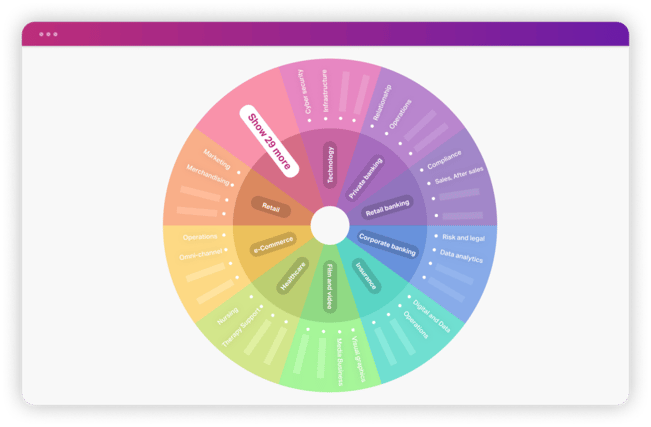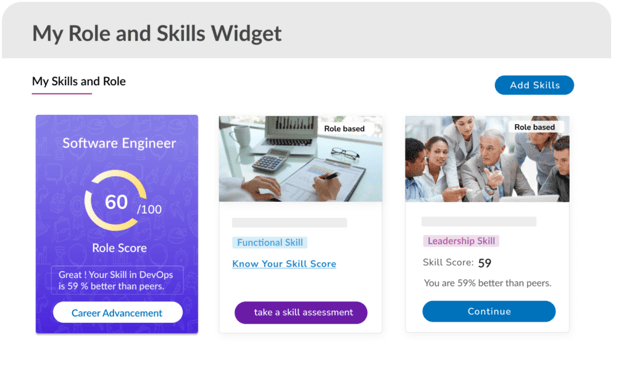Skill mapping will provide valuable insights to ongoing questions about necessary skills in various roles for your company. How often have you wondered which skills are needed for your employees to meet their existing and future job requirements? Of those skills, which of them are the most important to obtain the best performance from your workforce?
How can you fill the skill gaps that employees need to be successful? Skill mapping offers an understanding of what skills an organization has, which are necessary skills, and how that is likely to change in the future. Skill mapping is ultimately used to drive desired business outcomes.
What Is Skill Mapping?
The skills mapping process identifies current and future required skills needed by employees and organizations, assessing their strengths, weaknesses, and competency to determine the talent and skills gaps that need to be filled to meet the business requirements now and as they evolve.

Each job role in an organization has many skills that employees must master to ensure high performance. In fact, Gartner notes that 58% of the workforce requires new skills to get their job done. The number of skills needed has also been increasing by 10% every year since 2017.
Skill mapping is an important part of training, learning, and development. First, you must determine what the required skills are to do each job. Then you do a skills assessment for each individual employee to identify their current skill level and identify the gaps that you will need to fill with learning and development.
Recent reports indicate that 66% of organizations are turning toward skill mapping as a way to ensure that their team has the necessary skills to move forward in uncertain times. This shows why it’s considered increasingly important to engage in mapping employee skills for companies in any industry.
5 Different Types of Skill Mapping
Types of skill mapping can be categorized based on the specific objectives it aims to achieve.
These categories include

1) Job-Based Skill Mapping
Focuses on identifying the skills necessary for a particular job and aligning them with individuals or teams. This ensures the right talent is matched with the right roles to optimize performance.
2) Performance-Based Skill Mapping
Evaluates employees or groups based on their performance with their job responsibilities. This helps identify strengths and areas for improvement, driving targeted development efforts.
3) Competency-Based Skill Mapping
Assess the core competencies needed for overall organizational success, ensuring that employees possess the skills crucial to achieving company goals. This approach fosters a well-rounded workforce capable of adapting to evolving business needs.
4) Succession-Based Skill Mapping
Identifies potential successors for key roles within the organization, ensuring a pipeline of capable candidates for leadership or critical positions. This proactive approach helps maintain business continuity and reduces risks associated with unexpected vacancies.
5) Career-Based Skill Mapping
Examines the skills necessary for employees to advance in their careers, helping individuals identify areas for development and growth within the organization. This process encourages continuous learning and provides clear pathways for career progression.
Five Benefits of Skill Mapping
Now that you know what skill mapping is and why it’s important, we will share some of the top benefits of skills mapping to enhance L&D.
1) Identify Skills Gaps
2) Succession Planning
3) Increase Employee Engagement and Retention
4) Talent Management
5) Track the Progress of Specific Teams
The 5 Benefits are as follows
1) Identify Skills Gaps
When you engage in skill mapping, you utilize a repository of the skills for each job role in your organization. Assessments and/or manager reviews are normally used to identify skill gaps. Knowing where the skill level and gaps lie is important for determining what learning and development is needed to fill them.

Not only can Identifying skills gaps help build training programs but it can help create new and relevant roles to meet the needs of the team and strengthen your company. You will now be able to hire new talent with the right skills to fill the skills gaps.
2) Succession Planning
Nobody stays in an organization forever. When someone moves on, you need someone who can fill their shoes. Skill mapping lets you identify the employees who have the potential to move into leadership roles in the business.
When you identify those employees and give them the tools needed to develop, you get a robust pool of candidates to choose from, without recruitment of new talent, when you need to move forward with succession planning.
3) Increase Employee Engagement and Retention
Skill mapping has been shown to increase job satisfaction and employee engagement, which can lead to better business growth and productivity. It also shows employees a career path in the organization. This can create better employee engagement and retention. Aligning with employee goals motivates these individuals to perform at their best and participate in training programs to learn the right skills. This is a win-win for workers and the organization as a whole.
4) Talent Management
Having a skill map lets an organization make better-informed decisions about which people to hire and what employees should be promoted. When you know what capabilities and skills an employee has, it can drive strategic decisions about how to utilize and develop their skill set, no matter what they are.
5) Track the Progress of Specific Teams
Tracking the progress of your team is a great way to make sure things are moving forward. Skill tracking is one way to do this. You can use it to see where certain employees stand, how different teams are doing, and what to expect from one department compared to another.
Keeping track of a team’s learning curve is essential to meeting goals and can be done by using skill mapping. It’s an essential part of improving departments and being fully aware of what you can expect from individual employees.
Skill Mapping Challenges in 2025
The skill mapping challenges of 2025 are as follows
-
Skills mapping depends on accurate data; incomplete or biased information, especially from self-evaluations, can lead to misjudged skills and poor decisions. Ensuring data integrity and employing reliable assessment methods are crucial to overcoming this challenge.
-
Modern roles often require a wider skill range than traditional descriptions cover, risking inaccurate skills assessments if not adopted. Adapting job descriptions and considering emerging skills are essential for accurate skills mapping.
-
Employees may resist skills mapping due to fears about exposing weaknesses or job security; clear communication about benefits can help overcome this. Providing reassurance and demonstrating how skills mapping supports career growth can alleviate concerns.
-
Managing skills mapping across large or multiple departments can be challenging; without a consistent strategy, results may be inconclusive and insights limited. Implementing standardized processes and tools can help ensure consistency and effective analysis.
-
Limited resources for learning and development can undermine skills mapping efforts, hindering meaningful training and development opportunities. Prioritizing resource allocation and exploring cost-effective training solutions can enhance the impact of skills mapping.
Best Practices for Implementing Skill Mapping
Skill mapping best practices to overcome challenges are

Invest in Data Quality Tools
To manage the complexity of data collection, invest in an LMS with robust analytics and reporting. This ensures timely, accurate data and enables training adjustments based on insights. Additionally, advanced analytics can help identify emerging skills gaps and trends, allowing for proactive strategy adjustments.
Keep Skills Mapping Agile
Job roles evolve constantly, so your skills mapping strategies must adapt. Regularly review skills matrices to reflect progress and detect transferable skills, while staying aligned with industry trends. This proactive approach ensures that your skills mapping remains relevant and effectively supports both current and future organizational needs.
Ensure Employee Engagement
Involve employees in skills mapping to boost engagement and transparency. Clear communication reassures them about the benefits, reducing resistance and building trust. Actively seeking their feedback also helps tailor the process to better meet their needs and career aspirations.
Exchange Feedback
Open communication between leaders and employees is key. Collect feedback regularly to gauge how skills mapping impacts the workforce beyond quantitative data. This ongoing dialogue helps identify areas for improvement and ensures that the process remains relevant and effective.
Standardize Processes
Consistency is crucial, especially across departments. Categorize skills, establish a rating system, and standardize documentation to analyze data uniformly across teams. This approach ensures reliable comparisons and supports coherent decision-making throughout the organization.
Foster a Continuous Learning Culture
Make skills mapping ongoing. Encourage lifelong learning by aligning training with employee learning goals and demonstrating the long-term benefits of professional development. Regularly update learning plans to keep pace with evolving industry standards and personal growth aspirations.
How Leveraging an LXP Enhances Skill Mapping Initiatives for Your Organization
With skill mapping being such an essential task for organizations around the globe, you might wonder how to put it into place at your own organization. To do that, you need the right software solution. While there are many choices available, there’s nothing better than Disprz LXP.

This platform features an AI-powered upskilling solution to ensure you have skilled workers in the organization at all times. Achieve learning and upskilling with personalized solutions and a repository of information across a robust learning management platform. If you’re ready to delve into skill mapping, download the demo and get started now.








